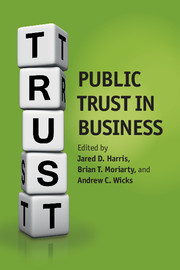Book contents
- Frontmatter
- Contents
- List of figures
- List of tables
- Notes on contributors
- Preface: discovering new territory in public trust in business
- Acknowledgments
- 1 Public trust in business: what’s the problem and why does it matter?
- Part I Trusting the institution of business
- Part II Public trust and business organizations
- Index
- References
1 - Public trust in business: what’s the problem and why does it matter?
Published online by Cambridge University Press: 05 July 2014
- Frontmatter
- Contents
- List of figures
- List of tables
- Notes on contributors
- Preface: discovering new territory in public trust in business
- Acknowledgments
- 1 Public trust in business: what’s the problem and why does it matter?
- Part I Trusting the institution of business
- Part II Public trust and business organizations
- Index
- References
Summary
EXECUTIVE SUMMARY
the situation
Survey data indicates that low public trust in business is an enduring phenomenon, but does not illuminate the underlying causes of this reality. While significant academic research has been done in the areas of interpersonal and interorganizational trust, little has been done in the area of public trust in business. This makes it difficult for business leaders to truly understand the problems posed by a lack of public trust and creates hurdles for their efforts to build and maintain public trust.
key questions
What do business leaders know about building public trust in their companies? What don’t they know and how might that be important for their particular business? What factors play a role in low levels of public trust in business? Why does trust matter to companies? What are the core dynamics of trust in business?
new knowledge
Public trust in business is a highly complex phenomenon that is impacted by social and technological change. Low trust in business is not the result of a single factor, but rather emerges from the interaction of multiple causes. Some aspects of what shapes public trust in business seem fairly constant and stable over time (e.g., suspicion of large institutions) other dimensions seem more contextual and fluid (e.g., the rise of the internet, information sharing, and the decrease in direct human interaction as a part of business).
- Type
- Chapter
- Information
- Public Trust in Business , pp. 1 - 16Publisher: Cambridge University PressPrint publication year: 2014

